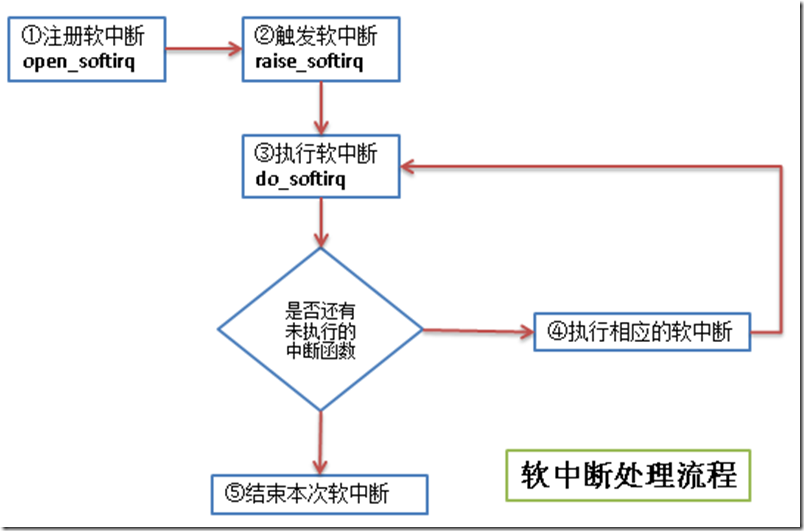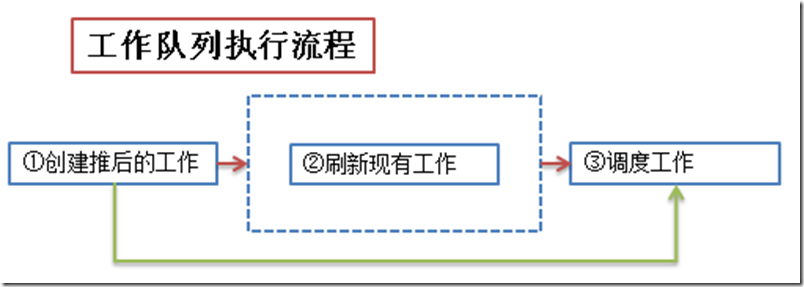《Linux内核设计与实现》读书笔记(八)- 中断下半部的处理
在前一章也提到过,之所以中断会分成上下两部分,是由于中断对时限的要求非常高,需要尽快的响应硬件。
主要内容:
- 中断下半部处理
- 实现中断下半部的机制
- 总结中断下半部的实现
- 中断实现示例
1. 中断下半部处理
那么对于一个中断,如何划分上下两部分呢?哪些处理放在上半部,哪些处理放在下半部?
这里有一些经验可供借鉴:
- 如果一个任务对时间十分敏感,将其放在上半部
- 如果一个任务和硬件有关,将其放在上半部
- 如果一个任务要保证不被其他中断打断,将其放在上半部
- 其他所有任务,考虑放在下半部
2. 实现中断下半部的机制
实现下半部的方法很多,随着内核的发展,产生了一些新的方法,也淘汰了一些旧方法。
目前使用最多的是以下3中方法
- 2.1 软中断
- 2.2 tasklet
- 2.3 工作队列
2.1 软中断
软中断的代码在:kernel/softirq.c
软中断的流程如下:
流程图中几个步骤的说明:
① 注册软中断的函数 open_softirq参见 kernel/softirq.c文件)
/* * 将软中断类型和软中断处理函数加入到软中断序列中 * @nr - 软中断类型 * @(*action)(struct softirq_action *) - 软中断处理的函数指针 */ void open_softirq(int nr, void (*action)(struct softirq_action *)) { /* softirq_vec是个struct softirq_action类型的数组 */ softirq_vec[nr].action = action; }
软中断类型目前有10个,其定义在 include/linux/interrupt.h 文件中:
enum { HI_SOFTIRQ=0, TIMER_SOFTIRQ, NET_TX_SOFTIRQ, NET_RX_SOFTIRQ, BLOCK_SOFTIRQ, BLOCK_IOPOLL_SOFTIRQ, TASKLET_SOFTIRQ, SCHED_SOFTIRQ, HRTIMER_SOFTIRQ, RCU_SOFTIRQ, /* Preferable RCU should always be the last softirq */ NR_SOFTIRQS };
struct softirq_action 的定义也在 include/linux/interrupt.h 文件中
/* * 这个结构体的字段是个函数指针,字段名称是action * 函数指针的返回指是void型 * 函数指针的参数是 struct softirq_action 的地址,其实就是指向 softirq_vec 中的某一项 * 如果 open_softirq 是这样调用的: open_softirq(NET_TX_SOFTIRQ, my_tx_action); * 那么 my_tx_action 的参数就是 softirq_vec[NET_TX_SOFTIRQ]的地址 */ struct softirq_action { void (*action)(struct softirq_action *); };
② 触发软中断的函数 raise_softirq 参见 kernel/softirq.c文件
/* * 触发某个中断类型的软中断 * @nr - 被触发的中断类型 * 从函数中可以看出,在处理软中断前后有保存和恢复寄存器的操作 */ void raise_softirq(unsigned int nr) { unsigned long flags; local_irq_save(flags); raise_softirq_irqoff(nr); local_irq_restore(flags); }
③ 执行软中断 do_softirq 参见 kernel/softirq.c文件
asmlinkage void do_softirq(void) { __u32 pending; unsigned long flags; /* 判断是否在中断处理中,如果正在中断处理,就直接返回 */ if (in_interrupt()) return; /* 保存当前寄存器的值 */ local_irq_save(flags); /* 取得当前已注册软中断的位图 */ pending = local_softirq_pending(); /* 循环处理所有已注册的软中断 */ if (pending) __do_softirq(); /* 恢复寄存器的值到中断处理前 */ local_irq_restore(flags); }
④ 执行相应的软中断 - 执行自己写的中断处理
linux中,执行软中断有专门的内核线程,每个处理器对应一个线程,名称ksoftirqd/n (n对应处理器号)
通过top命令查看我的单核虚拟机,CentOS系统中的ksoftirqd线程如下:
[root@vbox ~]# top | grep ksoftirq 4 root 20 0 0 0 0 S 0.0 0.0 0:00.02 ksoftirqd/0
2.2 tasklet
tasklet也是利用软中断来实现的,但是它提供了比软中断更好用的接口(其实就是基于软中断又封装了一下),
所以除了对性能要求特别高的情况,一般建议使用tasklet来实现自己的中断。
tasklet对应的结构体在 <linux/interrupt.h> 中
struct tasklet_struct { struct tasklet_struct *next; /* 链表中的下一个tasklet */ unsigned long state; /* tasklet状态 */ atomic_t count; /* 引用计数器 */ void (*func)(unsigned long); /* tasklet处理函数 */ unsigned long data; /* tasklet处理函数的参数 */ };
tasklet状态只有3种值:
- 值 0 表示该tasklet没有被调度
- 值 TASKLET_STATE_SCHED 表示该tasklet已经被调度
- 值 TASKLET_STATE_RUN 表示该tasklet已经运行
引用计数器count 的值不为0,表示该tasklet被禁止。
tasklet使用流程如下:
1. 声明tasklet (参见<linux/interrupt.h>)
/* 静态声明一个tasklet */ #define DECLARE_TASKLET(name, func, data) \ struct tasklet_struct name = { NULL, 0, ATOMIC_INIT(0), func, data } #define DECLARE_TASKLET_DISABLED(name, func, data) \ struct tasklet_struct name = { NULL, 0, ATOMIC_INIT(1), func, data } /* 动态声明一个tasklet 传递一个tasklet_struct指针给初始化函数 */ extern void tasklet_init(struct tasklet_struct *t, void (*func)(unsigned long), unsigned long data);
2. 编写处理程序
参照tasklet处理函数的原型来写自己的处理逻辑
void tasklet_handler(unsigned long date)
3. 调度tasklet
中断的上半部处理完后调度tasklet,在适当时候进行下半部的处理
tasklet_schedule(&my_tasklet) /* my_tasklet就是之前声明的tasklet_struct */
2.3 工作队列
工作队列子系统是一个用于创建内核线程的接口,通过它可以创建一个工作者线程来专门处理中断的下半部工作。
工作队列和tasklet不一样,不是基于软中断来实现的。
缺省的工作者线程名称是 events/n (n对应处理器号)。
通过top命令查看我的单核虚拟机,CentOS系统中的events线程如下:
[root@vbox ~]# top | grep event 7 root 20 0 0 0 0 S 0.0 0.0 0:03.71 events/0
工作队列主要用到下面3个结构体,弄懂了这3个结构体的关系,也就知道工作队列的处理流程了。
/* 在 include/linux/workqueue.h 文件中定义 */ struct work_struct { atomic_long_t data; /* 这个并不是处理函数的参数,而是表示此work是否pending等状态的flag */ #define WORK_STRUCT_PENDING 0 /* T if work item pending execution */ #define WORK_STRUCT_FLAG_MASK (3UL) #define WORK_STRUCT_WQ_DATA_MASK (~WORK_STRUCT_FLAG_MASK) struct list_head entry; /* 中断下半部处理函数的链表 */ work_func_t func; /* 处理中断下半部工作的函数 */ #ifdef CONFIG_LOCKDEP struct lockdep_map lockdep_map; #endif }; /* 在 kernel/workqueue.c文件中定义 * 每个工作者线程对应一个 cpu_workqueue_struct ,其中包含要处理的工作的链表 * (即 work_struct 的链表,当此链表不空时,唤醒工作者线程来进行处理) */ /* * The per-CPU workqueue (if single thread, we always use the first * possible cpu). */ struct cpu_workqueue_struct { spinlock_t lock; /* 锁保护这种结构 */ struct list_head worklist; /* 工作队列头节点 */ wait_queue_head_t more_work; struct work_struct *current_work; struct workqueue_struct *wq; /* 关联工作队列结构 */ struct task_struct *thread; /* 关联线程 */ } ____cacheline_aligned; /* 也是在 kernel/workqueue.c 文件中定义的 * 每个 workqueue_struct 表示一种工作者类型,系统默认的就是 events 工作者类型 * 每个工作者类型一般对应n个工作者线程,n就是处理器的个数 */ /* * The externally visible workqueue abstraction is an array of * per-CPU workqueues: */ struct workqueue_struct { struct cpu_workqueue_struct *cpu_wq; /* 工作者线程 */ struct list_head list; const char *name; int singlethread; int freezeable; /* Freeze threads during suspend */ int rt; #ifdef CONFIG_LOCKDEP struct lockdep_map lockdep_map; #endif };
使用工作者队列的方法见下图:
① 创建推后执行的工作 - 有静态创建和动态创建2种方法
/* 静态创建一个work_struct * @n - work_struct结构体,不用事先定义 * @f - 下半部处理函数 */ #define DECLARE_WORK(n, f) \ struct work_struct n = __WORK_INITIALIZER(n, f) /* 动态创建一个 work_struct * @_work - 已经定义好的一个 work_struct * @_func - 下半部处理函数 */ #ifdef CONFIG_LOCKDEP #define INIT_WORK(_work, _func) \ do { \ static struct lock_class_key __key; \ \ (_work)->data = (atomic_long_t) WORK_DATA_INIT(); \ lockdep_init_map(&(_work)->lockdep_map, #_work, &__key, 0);\ INIT_LIST_HEAD(&(_work)->entry); \ PREPARE_WORK((_work), (_func)); \ } while (0) #else #define INIT_WORK(_work, _func) \ do { \ (_work)->data = (atomic_long_t) WORK_DATA_INIT(); \ INIT_LIST_HEAD(&(_work)->entry); \ PREPARE_WORK((_work), (_func)); \ } while (0) #endif
工作队列处理函数的原型:
typedef void (*work_func_t)(struct work_struct *work);
② 刷新现有的工作,这个步骤不是必须的,可以直接从第①步直接进入第③步
刷新现有工作的意思就是在追加新的工作之前,保证队列中的已有工作已经执行完了。
/* 刷新系统默认的队列,即 events 队列 */ void flush_scheduled_work(void); /* 刷新用户自定义的队列 * @wq - 用户自定义的队列 */ void flush_workqueue(struct workqueue_struct *wq);
③ 调度工作 - 调度新定义的工作,使之处于等待处理器执行的状态
/* 调度第一步中新定义的工作,在系统默认的工作者线程中执行此工作 * @work - 第一步中定义的工作 */ schedule_work(struct work_struct *work); /* 调度第一步中新定义的工作,在系统默认的工作者线程中执行此工作 * @work - 第一步中定义的工作 * @delay - 延迟的时钟节拍 */ int schedule_delayed_work(struct delayed_work *work, unsigned long delay); /* 调度第一步中新定义的工作,在用户自定义的工作者线程中执行此工作 * @wq - 用户自定义的工作队列类型 * @work - 第一步中定义的工作 */ int queue_work(struct workqueue_struct *wq, struct work_struct *work); /* 调度第一步中新定义的工作,在用户自定义的工作者线程中执行此工作 * @wq - 用户自定义的工作队列类型 * @work - 第一步中定义的工作 * @delay - 延迟的时钟节拍 */ int queue_delayed_work(struct workqueue_struct *wq, struct delayed_work *work, unsigned long delay);
3. 总结中断下半部的实现
下面对实现中断下半部工作的3种机制进行总结,便于在实际使用中决定使用哪种机制
|
下半部机制 |
上下文 |
复杂度 |
执行性能 |
顺序执行保障 |
| 软中断 | 中断 | 高 (需要自己确保软中断的执行顺序及锁机制) |
好 (全部自己实现,便于调优) |
没有 |
| tasklet | 中断 | 中 (提供了简单的接口来使用软中断) |
中 | 同类型不能同时执行 |
| 工作队列 | 进程 | 低 (在进程上下文中运行,与写用户程序差不多) |
差 | 没有 (和进程上下文一样被调度) |
4. 中断实现示例
4.1 软中断的实现
本来想用内核模块的方法来测试一下软中断的流程,但是编译时发现软中断注册函数(open_softirq)和触发函数(raise_softirq)
并没有用EXPORT_SYMBOL导出,所以自定义的内核模块中无法使用。
测试的代码如下:
#include <linux/interrupt.h> #include "kn_common.h" MODULE_LICENSE("Dual BSD/GPL"); static void my_softirq_func(struct softirq_action*); static int testsoftirq_init(void) { // 注册softirq,这里注册的是定时器的下半部 open_softirq(TIMER_SOFTIRQ, my_softirq_func); // 触发softirq raise_softirq(TIMER_SOFTIRQ); return 0; } static void testsoftirq_exit(void) { printk(KERN_ALERT "*************************\n"); print_current_time(0); printk(KERN_ALERT "testrbtree is exited!\n"); printk(KERN_ALERT "*************************\n"); } static void my_softirq_func(struct softirq_action* act) { printk(KERN_ALERT "=========================\n"); print_current_time(0); printk(KERN_ALERT "my softirq function is been called!....\n"); printk(KERN_ALERT "=========================\n"); } module_init(testsoftirq_init); module_exit(testsoftirq_exit);
其中头文件 kn_common.h 的相关内容参见之前的博客《Linux内核设计与实现》读书笔记(六)- 内核数据结构
由于内核没有用EXPORT_SYMBOL导出open_softirq和raise_softirq函数,所以编译时有如下警告:
WARNING: "open_softirq" [/root/chap08/mysoftirq.ko] undefined! WARNING: "raise_softirq" [/root/chap08/mysoftirq.ko] undefined!
注:编译用的系统时centos6.3 (uname -r结果 - 2.6.32-279.el6.x86_64)
没办法,只能尝试修改内核代码(将open_softirq和raise_softirq用EXPORT_SYMBOL导出),再重新编译内核,然后再尝试能否测试软中断。
主要修改2个文件,(既然要修改代码,干脆加了一种软中断类型):
/* 修改 kernel/softirq.c */ // ... 略 ... char *softirq_to_name[NR_SOFTIRQS] = { "HI", "TIMER", "NET_TX", "NET_RX", "BLOCK", "BLOCK_IOPOLL", "TASKLET", "SCHED", "HRTIMER", "RCU", "WYB" }; /* 追加了一种新的softirq,即 "WYB",我名字的缩写 ^_^ */ // ... 略 ... void raise_softirq(unsigned int nr) { unsigned long flags; local_irq_save(flags); raise_softirq_irqoff(nr); local_irq_restore(flags); } EXPORT_SYMBOL(raise_softirq); /* 追加的代码 */ void open_softirq(int nr, void (*action)(struct softirq_action *)) { softirq_vec[nr].action = action; } EXPORT_SYMBOL(open_softirq); /* 追加的代码 */ // ... 略 ... /* 还修改了 include/linux/interrupt.h */ enum { HI_SOFTIRQ=0, TIMER_SOFTIRQ, NET_TX_SOFTIRQ, NET_RX_SOFTIRQ, BLOCK_SOFTIRQ, BLOCK_IOPOLL_SOFTIRQ, TASKLET_SOFTIRQ, SCHED_SOFTIRQ, HRTIMER_SOFTIRQ, RCU_SOFTIRQ, /* Preferable RCU should always be the last softirq */ WYB_SOFTIRQS, /* 追加的一种中断类型 */ NR_SOFTIRQS };
重新编译内核后,在新的内核上再次实验软中断代码:
(编译内核方法参见:《Linux内核设计与实现》读书笔记(五)- 系统调用 3.3节)
测试软中断的代码:testsoftirq.c
#include <linux/interrupt.h> #include "kn_common.h" MODULE_LICENSE("Dual BSD/GPL"); static void my_softirq_func(struct softirq_action*); static int testsoftirq_init(void) { printk(KERN_ALERT "interrupt's top half!\n"); // 注册softirq,这里注册的是自定义的软中断类型 open_softirq(WYB_SOFTIRQS, my_softirq_func); // 触发softirq raise_softirq(WYB_SOFTIRQS); return 0; } static void testsoftirq_exit(void) { printk(KERN_ALERT "*************************\n"); print_current_time(0); printk(KERN_ALERT "testsoftirq is exited!\n"); printk(KERN_ALERT "*************************\n"); } static void my_softirq_func(struct softirq_action* act) { printk(KERN_ALERT "=========================\n"); print_current_time(0); printk(KERN_ALERT "my softirq function is been called!....\n"); printk(KERN_ALERT "=========================\n"); } module_init(testsoftirq_init); module_exit(testsoftirq_exit);
Makefile:
obj-m += mysoftirq.o mysoftirq-objs := testsoftirq.o kn_common.o #generate the path CURRENT_PATH:=$(shell pwd) #the current kernel version number LINUX_KERNEL:=$(shell uname -r) #the absolute path LINUX_KERNEL_PATH:=/usr/src/kernels/$(LINUX_KERNEL) #complie object all: make -C $(LINUX_KERNEL_PATH) M=$(CURRENT_PATH) modules rm -rf modules.order Module.symvers .*.cmd *.o *.mod.c .tmp_versions *.unsigned #clean clean: rm -rf modules.order Module.symvers .*.cmd *.o *.mod.c *.ko .tmp_versions *.unsigned
测试软中断的方法如下:
make insmod mysoftirq.ko rmmod mysoftirq dmesg | tail -9 # 运行结果 interrupt's top half! ========================= 2013-4-22 14:4:57 my softirq function is been called!.... ========================= ************************* 2013-4-22 14:5:2 testsoftirq is exited! *************************
4.2 tasklet的实现
tasklet的实验用默认的内核即可,我们切换到centos6.3的默认内核(uname -r: 2.6.32-279.el6.x86_64)
从中我们也可以看出,内核之所以没有导出open_softirq和raise_softirq函数,可能还是因为提倡我们尽量用tasklet来实现中断的下半部工作。
tasklet测试代码:testtasklet.c
#include <linux/interrupt.h> #include "kn_common.h" MODULE_LICENSE("Dual BSD/GPL"); static void my_tasklet_func(unsigned long); /* mytasklet 必须定义在testtasklet_init函数的外面,否则会出错 */ DECLARE_TASKLET(mytasklet, my_tasklet_func, 1000); static int testtasklet_init(void) { printk(KERN_ALERT "interrupt's top half!\n"); // 如果在这里定义的话,那么 mytasklet是函数的局部变量, // 后面调度的时候会找不到 mytasklet // DECLARE_TASKLET(mytasklet, my_tasklet_func, 1000); // 调度tasklet, 处理器会在适当时候执行这个tasklet tasklet_schedule(&mytasklet); return 0; } static void testtasklet_exit(void) { printk(KERN_ALERT "*************************\n"); print_current_time(0); printk(KERN_ALERT "testtasklet is exited!\n"); printk(KERN_ALERT "*************************\n"); } static void my_tasklet_func(unsigned long data) { printk(KERN_ALERT "=========================\n"); print_current_time(0); printk(KERN_ALERT "my tasklet function is been called!....\n"); printk(KERN_ALERT "parameter data is %ld\n", data); printk(KERN_ALERT "=========================\n"); } module_init(testtasklet_init); module_exit(testtasklet_exit);
Makefile:
obj-m += mytasklet.o mytasklet-objs := testtasklet.o kn_common.o #generate the path CURRENT_PATH:=$(shell pwd) #the current kernel version number LINUX_KERNEL:=$(shell uname -r) #the absolute path LINUX_KERNEL_PATH:=/usr/src/kernels/$(LINUX_KERNEL) #complie object all: make -C $(LINUX_KERNEL_PATH) M=$(CURRENT_PATH) modules rm -rf modules.order Module.symvers .*.cmd *.o *.mod.c .tmp_versions *.unsigned #clean clean: rm -rf modules.order Module.symvers .*.cmd *.o *.mod.c *.ko .tmp_versions *.unsigned
测试tasklet的方法如下:
make insmod mytasklet.ko rmmod mytasklet dmesg | tail -10 # 运行结果 interrupt's top half! ========================= 2013-4-22 14:53:14 my tasklet function is been called!.... parameter data is 1000 ========================= ************************* 2013-4-22 14:53:20 testtasklet is exited! *************************
4.3 工作队列的实现
workqueue的例子的中静态定义了一个工作,动态定义了一个工作。
静态定义的工作由系统工作队列(events/n)调度,
动态定义的工作由自定义的工作队列(myworkqueue)调度。
测试工作队列的代码:testworkqueue.c
#include <linux/workqueue.h> #include "kn_common.h" MODULE_LICENSE("Dual BSD/GPL"); static void my_work_func(struct work_struct *); static void my_custom_workqueue_func(struct work_struct *); /* 静态创建一个工作,使用系统默认的工作者线程,即 events/n */ DECLARE_WORK(mywork, my_work_func); static int testworkqueue_init(void) { /*自定义的workqueue */ struct workqueue_struct *myworkqueue = create_workqueue("myworkqueue"); /* 动态创建一个工作 */ struct work_struct *mywork2; mywork2 = kmalloc(sizeof(struct work_struct), GFP_KERNEL); INIT_WORK(mywork2, my_custom_workqueue_func); printk(KERN_ALERT "interrupt's top half!\n"); /* 刷新系统默认的队列 */ flush_scheduled_work(); /* 调度工作 */ schedule_work(&mywork); /* 刷新自定义的工作队列 */ flush_workqueue(myworkqueue); /* 调度自定义工作队列上的工作 */ queue_work(myworkqueue, mywork2); return 0; } static void testworkqueue_exit(void) { printk(KERN_ALERT "*************************\n"); print_current_time(0); printk(KERN_ALERT "my workqueue test is exited!\n"); printk(KERN_ALERT "*************************\n"); } static void my_work_func(struct work_struct *work) { printk(KERN_ALERT "=========================\n"); print_current_time(0); printk(KERN_ALERT "my workqueue function is been called!....\n"); printk(KERN_ALERT "=========================\n"); } static void my_custom_workqueue_func(struct work_struct *work) { printk(KERN_ALERT "=========================\n"); print_current_time(0); printk(KERN_ALERT "my cutomize workqueue function is been called!....\n"); printk(KERN_ALERT "=========================\n"); kfree(work); } module_init(testworkqueue_init); module_exit(testworkqueue_exit);
Makefile:
obj-m += myworkqueue.o myworkqueue-objs := testworkqueue.o kn_common.o #generate the path CURRENT_PATH:=$(shell pwd) #the current kernel version number LINUX_KERNEL:=$(shell uname -r) #the absolute path LINUX_KERNEL_PATH:=/usr/src/kernels/$(LINUX_KERNEL) #complie object all: make -C $(LINUX_KERNEL_PATH) M=$(CURRENT_PATH) modules rm -rf modules.order Module.symvers .*.cmd *.o *.mod.c .tmp_versions *.unsigned #clean clean: rm -rf modules.order Module.symvers .*.cmd *.o *.mod.c *.ko .tmp_versions *.unsigned
测试workqueue的方法如下:
make insmod myworkqueue.ko rmmod myworkqueue dmesg | tail -13 # 运行结果 interrupt's top half! ========================= 2013-4-23 9:55:29 my workqueue function is been called!.... ========================= ========================= 2013-4-23 9:55:29 my cutomize workqueue function is been called!.... ========================= ************************* 2013-4-23 9:55:29 my workqueue is exited! *************************





